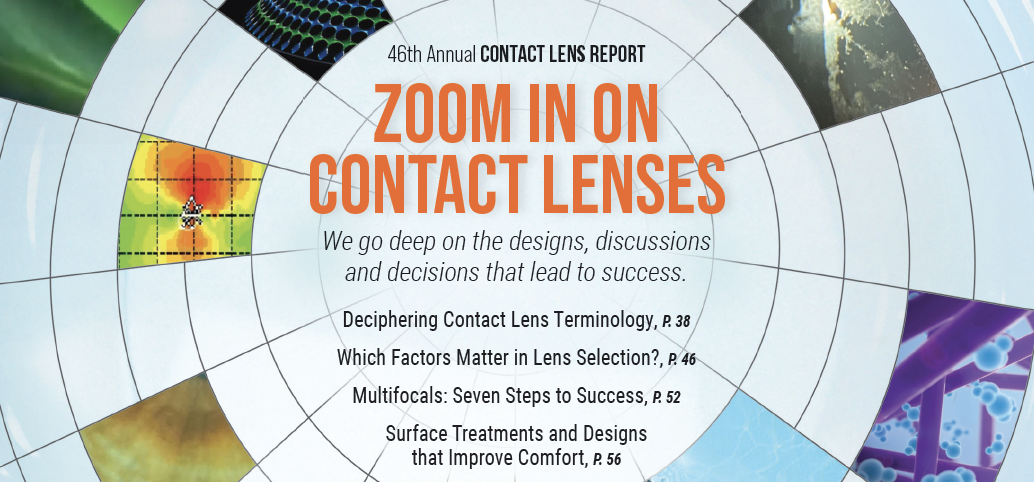Zoom in on Contact LensesThis August issue is our 46th annual contact lens report, where we help you use new and old techniques to improve your fitting skills. Check out the other featured articles here:
|
Sifting through the dozens of contact lens options available on the market today and choosing the one best suited for each patient can be overwhelming and time-consuming. No matter their refractive error or visual need, for nearly every patient you’re likely to find multiple lenses that could fit the bill. How do you determine the right one for each?
To further complicate the matter, contact lens companies often use their own ad hoc terminology—new concepts and phrases that power their marketing message, sometimes at the expense of clarity—to describe the functionality and design features of each lens, making it more difficult to determine what exactly makes the product unique. The lens manufacturers also seem smitten with the word “technology,” often using it as sort of a cherry on top of their marketing terms. The word gets appended to at least 18 different lens design attributes described in this article.
So, it is what it is: the genuinely good science behind these products sometimes takes a backseat to marketing maneuvers that aim for catchiness over clarity.
As their eyecare provider, your patients rely on you to recommend the most appropriate lens that will offer them the most optimal vision correction. To truly be informed on all the options that exist, practitioners have to learn how to decipher the marketing jargon. In this article, we translate the language used by several leading soft contact lens companies into words and concepts that any clinician can comprehend. The goal is to give you a clearer idea of which lenses serve which purpose for your patients.
Note that all product claims discussed below come from company literature and have not been independently verified.
Johnson & Johnson Vision
Though not the oldest contact lens company—that would be Bausch + Lomb, founded in 1853—or the one that launched the soft lens (B+L again), Johnson & Johnson’s consistent use of consumer advertising gives the company and its products a strong foothold in public perceptions of contact lenses, in particular the disposable lens category that it helped establish.
Acuvue by Johnson & Johnson Vision is one popular lens brand that offers vision correction solutions for patients across the whole spectrum of refractive error. The company carries 15 varieties of soft lenses, most of which are designed and marketed to aid with moisture retention and ocular dryness relief. They offer single-vision, toric and multifocal soft lenses with daily, biweekly or monthly replacement schedules. J&J Vision makes it fairly easy to remember which lenses it manufactures by including the name “Acuvue” in the title of each one. Its sub-brands include Acuvue Oasys, Acuvue Vita, Acuvue Moist and Acuvue TruEye.
Here are some commonly used terms found within the product line.
Lacreon Technology (in: 1-Day Acuvue Moist, 1-Day Acuvue Moist Multifocal, 1-Day Acuvue Moist for Astigmatism, 1-Day Acuvue Define).
HydraClear 1 (only in 1-Day Acuvue TruEye).
HydraClear Plus (in: Acuvue Oasys, Acuvue Oasys Multifocal with Pupil Optimized Design (which is replacing Acuvue Oasys for Presbyopia), Acuvue Oasys for Astigmatism).
HydraLuxe (in: Acuvue Oasys 1-Day, Acuvue Oasys 1-Day for Astigmatism).
HydraMax (in: Acuvue Vita, Acuvue Vita for Astigmatism).
Each of the innovations listed above serves to improve lens hydration and therefore patient comfort. Every one of these lenses features a formula that permanently embeds long-chain polyvinylpyrrolidone (PVP), a wetting agent, throughout the lens matrix. This mechanical design is what J&J Vision means by the phrase “Lacreon technology,” which was first introduced by the company in 2010 and since has evolved into other versions, including “HydraClear,” “HydraLuxe” and “HydraMax.” Its purpose is to mimic the mucin layer of the tear film and help to keep it stable. PVP is also amphiphilic, which means it has both hydrophilic (water-loving) and lipophilic (lipid-loving) structures and properties.
There are a few specific design aspects of the lens that differentiate each of these terms from the others, however. For example, HydraClear Plus contains a higher content of PVP than HydraClear 1, and HydraMax contains the highest level of PVP out of the three, which means that it offers the most lens moisture. Acuvue lenses with HydraClear Plus are made of senofilcon A, while the company’s “TruEye” lenses with HydraClear 1 have a narafilcon A material. Lenses made with HydraMax use senofilcon C.
While contact lenses may cause some patients discomfort and irritation to the ocular surface from disruption of the tear film, incorporating a wetting agent into the lens—such as the high-molecular-weight PVP used in each of these formulations—can assist in relieving symptoms of ocular dryness from contact lens wear. Additionally, internal wetting agents help solve the issue of saline solution drying up by the end of the day, which sometimes leads to frequent eye drop use. Most contact lenses on today’s market include some version of a wetting agent.
PVP is well studied and proven to be an effective and common treatment for dry eye, which suggests that lenses made with this ingredient might be beneficial for patients who suffer from symptoms of dry eye or dry eye disease.1
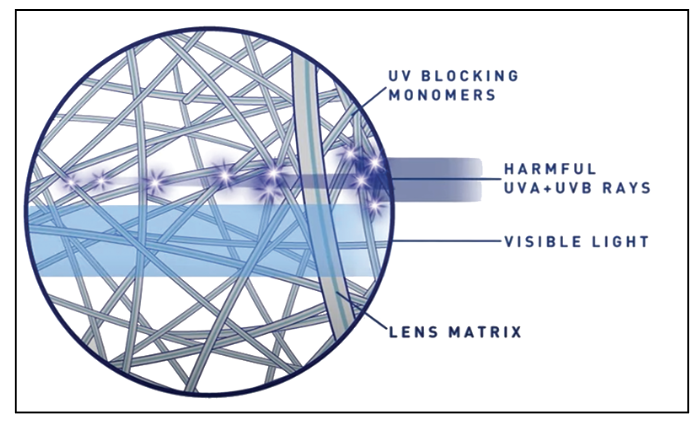 |
| J&J Vision touts the high level of UV blocking found in its products. Photo: J&J Vision. Click image to enlarge. |
Transitions Light Intelligent Technology (only in Acuvue Oasys with Transitions). These lenses are photochromic, meaning they automatically darken via a chemical reaction when exposed to UV light, and were developed in partnership with Transitions Optical, the ophthalmic lens company that popularized this concept in glasses.
J&J says that “Transitions light intelligent technology” enables the company’s Oasys with Transitions contact lenses to change from clear to dark in less than a minute. The specific design also enables lenses to fade back to clear in about 90 seconds when taken out of bright light.2 The company claims that this mechanism is able to work while still allowing the lenses to block out 100% of UVB rays.
One thing that several studies observed that may be important to note is the influence of temperature on the performance of these contact lenses. A study from 2021 that looked at the spectral transmittance of photochromic lenses reported that, “Temperature appears to influence both the activation and deactivation of photochromic contact lenses such that the higher the temperature, the greater the light transmission.”3 You may want to caution patients about this effect in case they do spend time in environments with extreme temperature fluctuations.
Aside from this consideration, photochromic lenses overall have demonstrated efficacy over spectacles or clear lenses in a handful of studies in easing visual transition in changing light conditions. Contact lens wearers who are more sensitive to indoor or outdoor light or find themselves squinting often to alleviate light intensity may benefit from photochromic lenses. Another attribute that sets Acuvue’s photochromic lenses apart the high level of UV protection, which surpasses that offered by most other lenses on the market.
An important disclaimer to make is that UV-absorbing contact lenses are not substitutes for protective UV-absorbing eyewear, such as UV-absorbing goggles or sunglasses, because they do not completely cover the eye and surrounding area. The patient should be advised to continue using UV-absorbing eyewear as directed.
Alcon
Like J&J, Alcon also offers soft lenses that correct myopia, hyperopia, presbyopia or astigmatism, with 14 different lens options. The lenses are replaced either daily or monthly. Alcon’s portfolio contains a variety of product lines, each manufactured with a unique lens polymer, including Dailies Total30, Dailies Total1, Precision1, Dailies AquaComfort Plus and Air Optix. Let’s decipher some of the company lingo.
AquaComfort Technology (Blink-activated Moisture) (in: Dailies AquaComfort Plus, Dailies AquaComfort Plus Toric and Dailies AquaComfort Plus Multifocal). As the name suggests, “blink-activated moisture” means that the lens is designed to release polyvinyl alcohol (PVA), a water soluble synthetic polymer. The material of all AquaComfort Plus lenses is primarily composed of crosslinked PVA, with non-crosslinked PVA floating in the lens matrix. When the patient blinks, the lens releases non-crosslinked PVA, thereby bolstering tear film stability and continuously hydrating the ocular surface. This agent has been used as an eye lubricant for decades and, like PVP, could help address patient complaints of moisture loss in their eyes or lenses after several hours of wear.
HydraGlyde Moisture Matrix (in: Air Optix Plus HydraGlyde, Air Optix Plus HydraGlyde for Multifocal, Air Optix Plus HydraGlyde for Astigmatism). Another lens feature made to help with long-lasting lens hydration, this formula by Alcon is a block copolymer (polyoxyethylene-polyoxybutylene) that embeds itself on and within the lens surface. It works to attract and retain moisture, creating a hydrophilic barrier between the lens and the eye.4 Like other wetting agents, this could reduce contact lens discomfort caused by mechanical friction of the lens that some patients experience.
The “HydraGlyde moisture matrix” is also featured in OptiFree PureMoist Multi-purpose Disinfecting Solution and Clear Care Plus with HydraGlyde.
SmartShield Technology (in: all monthly replacement lenses).
SmartSurface Technology (in: all Precision1 daily replacement lenses). The purpose of these two features, according to Alcon, is to form a permanent protective shield around the outer lens surface to help protect it from lipid deposits and to ensure a smooth wetting surface as a hedge against dryness. The micro-thin layer (approximately 2µm to 3µm thick) is made up of more than 80% water and is designed to help reduce the number of silicon atoms exposed to the lens surface while aiming to keep it hydrated. “SmartShield” and “SmartSurface” work through similar mechanisms, except the former is designed for monthly lenses while the latter is made for daily lenses. These may be viable options for patients who complain of bothersome deposit build-up or inadequate lens moisture.
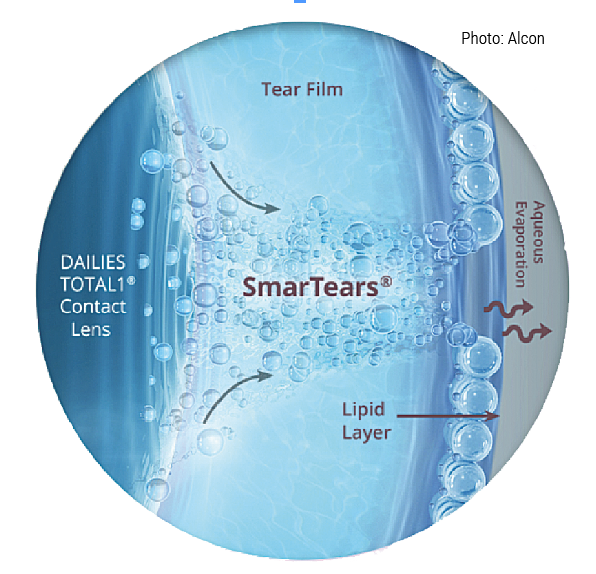 |
| Alcon’s “SmarTears technology” allows for the continous release of the wetting agent phosphatidylcholine into the tear film. Photo: Alcon. Click image to enlarge. |
SmarTears Technology (Dailies Total1, Dailies Total1 Multifocal, Dailies Total1 for Astigmatism). This mechanism allows for lenses to release phosphatidylcholine (PC)—a phospholipid found naturally in tears and in all cells in the body—as needed into the tear film to promote all-day moisture and a stabilized lipid layer. It’s designed specially for lens wearers who struggle with dry eye and is currently featured exclusively in the Dailies Total1 line of disposable lenses, where it works in conjunction with the next lens attribute on our list.
Water Gradient Technology (in: Dailies Total1 and Total30 lenses). Alcon made quite a splash (excuse the pun) when it debuted this lens design concept with the launch of the original Dailies Total1 lens in 2015. The lens core is 33% water to ensure high oxygen permeability and the water content gradually increases to nearly 100% at the lens surface to aid in moisture retention and comfort. It’s used throughout the DT1 line and also in the newer Total30 lens (where the core is 55% water rather than 33%). One study on the performance of the “water gradient” found that it was able to improve tear film dynamics and alleviate pathological break-up pattern.5
Celligent Technology (in: Total30). This is a term Alcon uses for a gel-like surface coating on Total30 lenses that helps the water gradient stay active for up to 30 days. It is meant to mimic the glycocalyx of the ocular surface, Alcon says, improving surface hydrophilicity and reducing the coefficient of friction.
Scleral Designs Get in on the ActThough marketing-friendly language is mostly confined to the soft contact lens market, the resurgence of interest in sclerals is bringing a little gloss to this category, too. The following two terms describe functional features of Zenlens scleral lenses: SmartCurve Technology and MicroVault Technology. Finding the perfect scleral lens fit for every patient’s unique cornea sometimes proves to be challenging. The objective behind the “smartcurve” feature in B+L’s Zenlens scleral lenses is to allow for a wide range of patients to receive a better-fitted lens through individually customizable parameters. The company claims that smartcurve is able to automatically adjust design attributes when a lens parameter is modified to ensure the patient receives a predictable fit. For example, if you increase the limbal clearance, B+L says that the other lens parameters (base curve and sagittal height) will automatically adjust. Another design aspect of Zenlens scleral lenses is what the company calls “microvault technology,” which creates a flute to help the lens to fit around a pinguecula. It can be applied to any lens design that has stabilization and works by contouring obstructions, such as pingueculae, to help provide patients with a more comfortable fit. In some scleral lens wearers with irregular corneas, the mechanism of the microvault feature may remove the need for the physician to notch out an area of the lens in order to achieve the proper fit. |
Precision Profile Design (in: Dailies Total1 Multifocal, Air Optix Aqua Multifocal). Featured in all of Alcon’s multifocal lens options, “precision profile design” is geared toward patients with presbyopia looking for better-quality vision across every distance range. This lens design includes the following three features that work together to deliver more seamless transitions from near to intermediate to distance vision:
- A bi-aspheric surface
- An adaptive minus power profile
- A center-near design
The double-aspheric lens design creates irregular curvature on both the front and back surfaces, making the lens thinner and more lightweight. This lens type is commonly used for patients with high prescriptions, as it helps improve vision quality and contrast through the reduced thickness of the lens center and edges. The adaptive minus power profile is made to minimize aberrations by enabling a smoother progression of power gradients from center-near to intermediate and distance. Finally, the center-near design tries to mimic the natural dilation and constriction of the pupil to help optimize the visual range.
Bausch + Lomb
This pioneer in refractive correction launched the first soft contact lens—the aptly named Soflens—just over 50 years ago and made great strides in establishing the market for such a product in its fledgling years.
Bausch + Lomb offers all the same soft lens types as Alcon and J&J (spherical, toric and multifocal), although it’s also one of two major contact lens manufacturers—the other being CooperVision—that offer a toric multifocal lens (B+L Ultra Multifocal for Astigmatism). Lenses are available with daily or monthly replacement schedules and the company currently has nine lens options available. The lenses are marketed under several sub-brands, including Infuse, Soflens, Biotrue Oneday, Ultra and PureVision. The venerable Soflens products—the ones that started it all back in 1971—are likely to be discontinued later this year.
Here are some of the terms the company uses to describe its lenses.
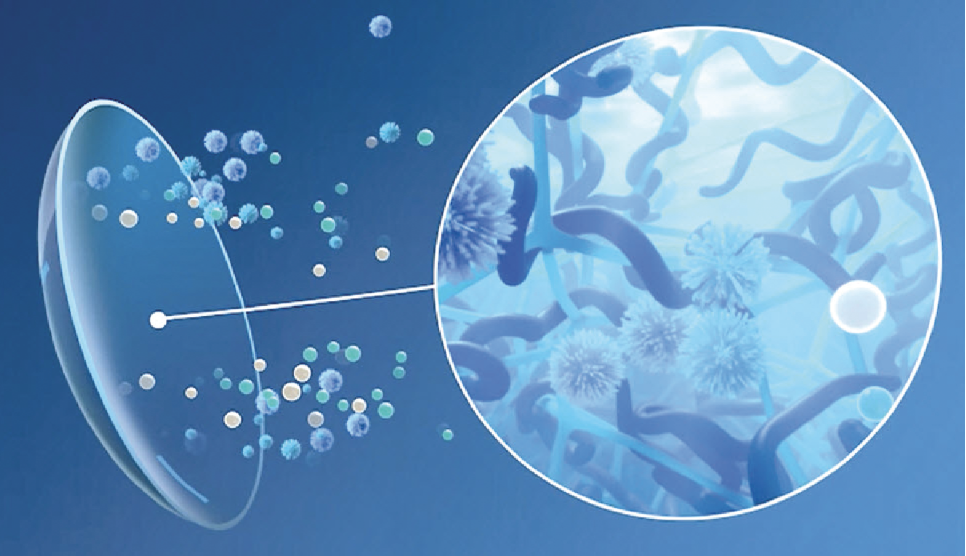 |
| B+L lenses with “ProBalance technology” feature a combination of several moisturizers that work together to help the tear film maintain its homeostasis during lens wear. Photo: B+L. Click image to enlarge. |
ProBalance Technology (only in Infuse Daily Contact Lenses). Inspired by findings in the Tear Film and Ocular Surface Society’s DEWS II report, B+L’s “ProBalance technology” uses a combination of ingredients including moisturizers that are infused into the lens and work to help maintain ocular surface homeostasis and reduce contact lens dryness. Here’s what makes up the formula:
- Erythritol and glycerin. These are osmoprotectants to help combat hyperosmotic stress.
- Potassium, an electrolyte to promote ocular homeostasis.
- Poloxamine 1107 and poloxamer 181, moisturizers that help the lens retain hydration and maintain tear proteins.
The “balance” in “ProBalance” hints at the formula’s purpose to minimize changes in ocular surface homeostasis that occur naturally throughout a day of lens wear. B+L claims the formula “balances” moisture, modulus and breathability in its Infuse daily lenses.
MoistureSeal Technology (in: B+L Ultra, Ultra for Astigmatism, Ultra Multifocal for Astigmatism and Ultra for Presbyopia). This mechanism aims to do exactly what its name implies: lock in moisture for up to 16 hours. “MoistureSeal” involves a two-phase polymerization process to optimize oxygen transmissibility and moisture retention:
- Phase 1: Creates a silicone backbone made of one long- and two short-chain monomers with a modulus of 70.
- Phase 2: PVP is integrated into the matrix. The molecular building blocks of PVP—the same wetting agent used in most Acuvue lenses— grow and surround the silicone backbone to attract moisture throughout the lens matrix.
B+L says that the design feature can help lenses maintain up to 95% of their moisture from morning to night. Patients who have tried other contact lenses and report that they became less comfortable by the end of the day might benefit from the long-lasting hydration that the company claims this polymerization process will provide.
Dual Elliptical Stabilization (in: Revive custom toric, NovaKone custom lenses for keratoconus, Astera multifocal toric). B+L acquired the company Alden Optical back in 2016, which introduced this lens feature to a handful of B+L’s toric and custom lenses for patients with astigmatism or keratoconus. “Dual elliptical stabilization” describes a process for ballasting meant to assist with lens orientation and rotational stability. More weight (extra material) is added to the lens around the three o’clock and nine o’clock positions, which is meant to help the lenses maintain the proper position and alignment of the axes as the person blinks.
CooperVision
Though lately celebrated for having the only FDA-approved lens for myopia control (the MiSight), CooperVision has a diverse portfolio that includes 14 soft lens varieties, and, like B+L, offers the entire array of soft lens types: single vision, toric, multifocal and toric multifocal. Replacement schedules are either daily, biweekly or monthly. The lens sub-brands include MyDay, Clariti, Biofinity, Avaira Vitality and MiSight. Let’s unpack the terminology about the unique features of each.
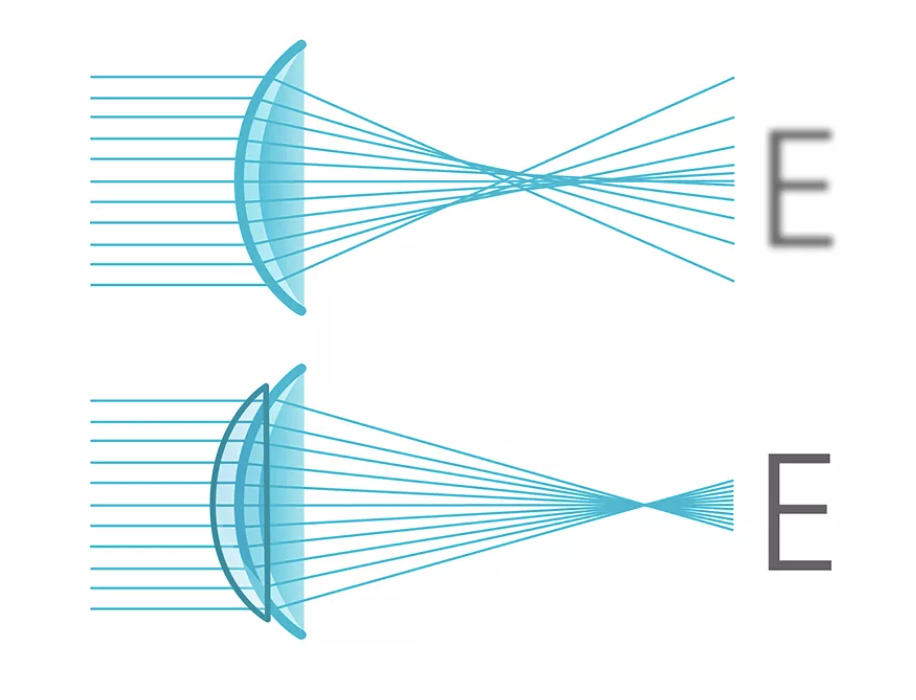 |
| The “aberration neutralizing system” used in some of CooperVision’s spherical lenses converges light rays to produce a single point of focus, as illustrated here. Photo: CooperVision. Click image to enlarge. |
Aberration Neutralizing System (in: MyDay daily disposable, Biofinity, Biomedics 55 premier, Avaira Vitality). This design feature aims to reduce bothersome spherical aberrations that can contribute to lower quality vision in some single-vision contact lens wearers. It’s incorporated into all of CooperVision’s spherical lenses and is meant to help patients see clearer in both dark and bright light. The “aberration neutralizing system” works by converging light rays as they hit the lens to produce a single point of focus that can help sharpen vision. This may be helpful to lens wearers who frequently complain of blurry vision, especially in low-light conditions or while driving at night.
ActivControl Technology (only in MiSight 1 day). CooperVision credits the ability of MiSight 1 day lenses to slow myopia progression in children to what it calls “ActivControl technology.” The lens features a dual-focus concentric ring multifocal design that combines several alternating distance correction and treatment zones to provide not only good vision but also signal to the eye to slow its growth.
Currently, these are the only daily disposable soft contact lenses on the market with an FDA indication for myopia control and that use a concentric-ring design for reducing axial length elongation in children.
Aquaform Technology (in: MyDay daily disposable, MyDay daily disposable toric, Biofinity, Biofinity Energys, Biofinity toric, Biofinity multifocal, Biofinity toric multifocal). The main intention of “Aquaform” is to offer lens wearers a higher level of oxygen permeability than many others on the market, according to the manufacturer.
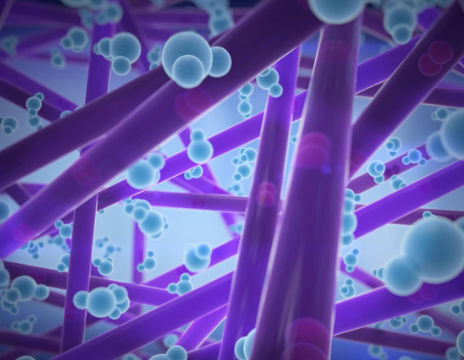 |
| “Aquaform technology” links hydrogen bonds to hydrophilic molecules to help certain CooperVision lenses maintain a higher water content. Photo: CooperVision. Click image to enlarge. |
CooperVision also claims that this specific design helps keep eyes hydrated with a material that’s made up of nearly 50% water. The lens is made up of a hydrophilic silicone hydrogel material that links hydrogen bonds to hydrophilic molecules to retain its high water content. For patients who don’t blink as often as they should—which is the case for most lens wearers in this digital age—lenses containing a higher water content may help to improve the comfort of wear by keeping eyes and lenses moist.
Balanced Progressive Technology (in: Biofinity multifocal, Biofinity toric multifocal, Proclear multifocal, Proclear multifocal toric).
Binocular Progressive System (in: MyDay Multifocal). Featured in most of CooperVision’s multifocals, “balanced progressive technology” gives each soft lens multiple vision-correction zones for near, intermediate and distance vision. What sets these lenses apart from some others that correct presbyopia is their ability to be tailored to each patient’s prescription. Doctors can choose a center-distance or center-near design based on the sphere and, for many patients, add the appropriate power needs.
The company’s “binocular progressive system” serves a similar function but is exclusive to MyDay multifocal lenses. These lenses also don’t offer as much customization as those that include the balanced progressive feature. Instead, MyDay multifocal lenses come in a set list of power variations for different levels of presbyopia.
Digital Zone Optics (only in Biofinity Energys). This design aims to help lens wearers combat eye strain from digital device use by easing stress on ciliary muscles. It claims to accomplish this through the multiple aspheric curves on the front surface of the lens—the “digital zone”—that are meant to distribute power more evenly, with most of the positive power in the center of the lens. Patients who use or work with screens often and complain that their eyes feel tired frequently may benefit from a lens designed to reduce accommodative burden, the company asserts. (See image two photos down).
Optimized Toric Lens Geometry (in: Avaira Vitality toric, Biofinity toric, Biofinity toric multifocal, MyDay daily disposable toric). These toric lenses include a set of features intended to keep the lens from moving, while also promoting clearer vision, a design approach that the developers describe as “optimized toric lens geometry.” The three features include:
- A curved back surface that allows the lens to “hug” the surface of the eye and maintain its position.
- A large toric optic zone that helps with vision performance.
- Uniform lens thicknesses in each horizontal cross-section that is meant to help improve vision clarity. In general, this means that the thickness of each cross-section doesn’t vary by greater than 10%.
Astigmats who have difficulty getting contact lenses to stay in place throughout the day or find that the lens stability is challenged by frequent blinking may be interested in a toric lens that uses a stabilization technique. CooperVision also has a toric stabilization method (“Blink Stabilized”), as does Alcon (“Precision Balance 8|4”).
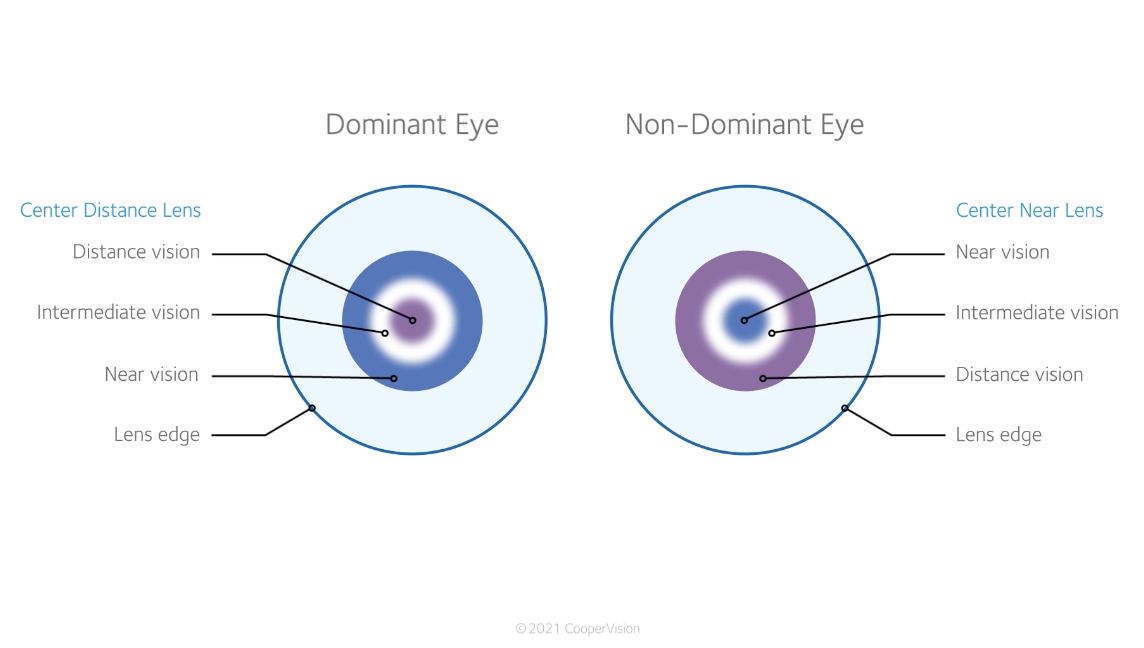 |
| This image shows the multiple vision correction zones featured in some of CooperVision’s multifocal and multifocal toric lenses, aiming to provide patients with clearer near, intermediate and distance vision. Photo: CooperVision. Click image to enlarge. |
PC Technology (in: Proclear, Proclear 1 day, Proclear 1 day multifocal, Proclear toric, Proclear multifocal, Proclear multifocal toric). The wetting agent featured in CooperVision’s “PC technology” is phosphorylcholine, which isn’t found naturally in the tear film. Like phosphatidylcholine (the agent in Alcon’s “SmarTears” discussed earlier, which is naturally found in the tear film), phosphorylcholine is a moisture-loving polymer that, when integrated into contact lenses, works to promote continuous hydration of the lens and tear film. The two molecules do share certain characteristics; they’re both moisture-loving and, when integrated into contact lenses, work to promote continuous hydration of the lens and tear film.
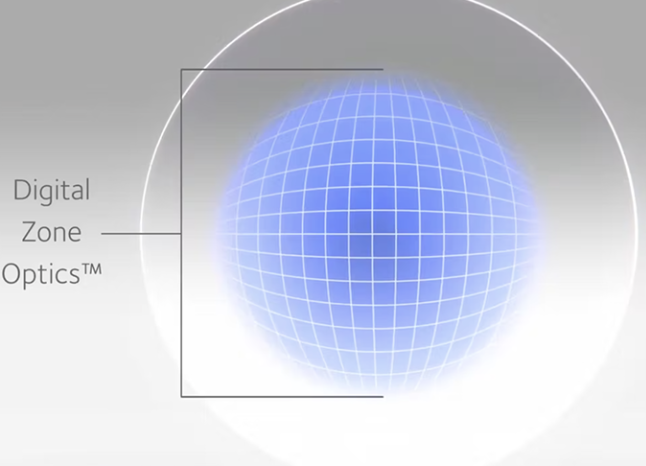 |
| Biofinity Energys lenses from CooperVision use “digital zone optics” to mitigate effects of digital screen use through multiple front-surface aspheric curves that work to reduce accommodative burden. Photo: CooperVision. Click image to enlarge. |
In every Proclear lens offered by CooperVision, the compound works by attracting water molecules in tears, which then bind to the lens surface. The company claims that this line of lenses maintains 96% of their original water content after 12 hours of wear.
There’s no clear answer to the question of which wetting agent provides superior lens hydration; as they say, different strokes for different folks. Just know that if you see “phosphatidylcholine,” “phosphorylcholine” or “PC” on contact lens ads or packaging, it means they aim to provide moisture retention and enhance the comfort of wear.
WetLoc Technology (in: Clariti 1-day, Clariti 1-day toric, Clariti 1-day multifocal). Another feature that prides itself on providing long-lasting hydration, the Clariti line of lenses is made with what Cooper calls “WetLoc technology,” meaning the silicone hydrogel material of the lens is designed with evenly dispersed moisture molecules intended to lock in moisture (as the name suggests) and resist dehydration. The absolute moisture retention of these lenses is among the highest on the market at 98.8% (relative moisture retention: 97.8%), according to CooperVision.
Menicon
This Japan-based company has a somewhat narrower product line than most others in the soft lens market. Each of Menicon’s soft lenses is marketed under the name “Miru,” which means “to see” in Japanese. The company offers spherical, toric and multifocal lenses that are replaced daily or monthly.
Smart Touch Technology (in: Miru 1day UpSide, Miru 1day UpSide multifocal, Miru 1day Menicon Flat Pack, Miru 1day Menicon Flat Pack toric, Miru 1day Menicon Flat Pack multifocal). Poor contact lens handling is a common issue among lens wearers of all ages and contributes to the incidence of infection and general ocular discomfort. In an attempt to provide a better solution than simply urging patients to be more careful with handwashing, Menicon designed special lens packaging to help address the issue. Formerly, all Miru 1day flat-pack lenses were packaged with “smart touch technology” made to promote germ-free handling.
With the recent launch of Miru UpSide lenses in 2021, the company had to redesign the packaging, which now features what Menicon calls a “smart zone”—a raised area in the packaging that allows for easier grasping with the fingers during product removal from the blister pack. The lenses are also packaged with the outer surface facing up so that the wearer can avoid touching the inner surface of the lens. The company claims that this helps reduce the risk of infection by discouraging fibers, bacteria and other microbes and contaminants on patients’ hands from coming in contact with the inner lens and being transferred onto the eye.
|
|
| Menicon’s Miru lenses are packaged facing downward, a feature the company markets as “smart touch technology.” This helps the patient insert the lens without touching its inner surface, aiming to reduce the risk of infection. The lenses themselves use a polymerization process that allows ultra high Dk/t (Menicon calls it MeniSilk) and a coating called NanoGloss for bacterial resistance and wettability. Photo: Menicon. Click image to enlarge. |
MeniSilk Air and NanoGloss Pro (in: Miru 1day UpSide, Miru 1day UpSide multifocal, Miru 1month Menicon, Menicon Premio, Menicon Premio toric). These two terms are used to describe the design characteristics of the material for Menicon’s entire line of lenses. They’re all made with a hydrophilic monomer and silicone polymerization that help them provide high oxygen permeability, a hydrating lens surface and optimized transparency. The surface of the lenses is also bacteria-resistant to help fight contamination and risk of infection.
Word Games
George Bernard Shaw once said, wryly, that America and England are “two countries separated by a common language,” as word choice and meaning within each culture can be quite different despite drawing from the same source. It sometimes feels the same way when optometrists attempt to read product literature from manufacturers. Learning how to decipher company descriptions can help you make better, more informed recommendations for your patients to increase the chance of a positive visual outcome for patients, and in turn, increases their satisfaction with your care.
1. Maulvi FA, Patel PJ, Soni PD, et al. Novel poly(vinylpyrrolidone) -coated silicone contact lenses to improve tear volume during lens wear: in vitro and in vivo studies. ACS Omega. 2020;5(29):18148-18154. |
